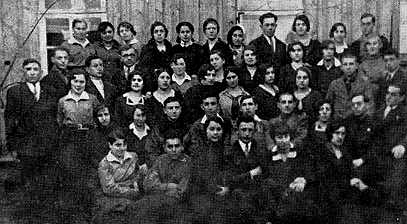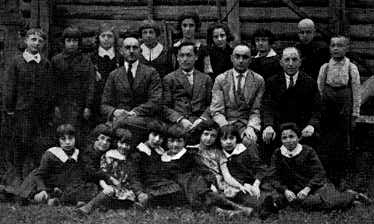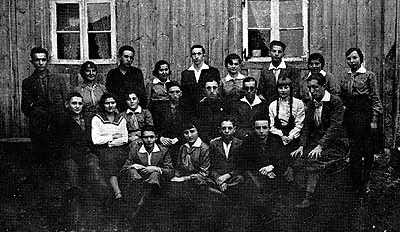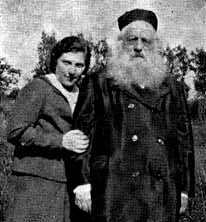
|
|
[Page 73]
Dokshitz dates from the eighteenth century, it is situated 60 kms. from Polotzek in Belorussia and about 200 kms. from Vilna. In 1920 the little town was captured by Poland and from then on belonged to the Vilna district. It had 4,500 inhabitants (before the war), 3,000 of them Jews and the remainder White Russians and a Polish minority (a few Tatar families as well). The railway that passed along the little town of Parpinov at a distance of 10 kms. was the only link with Vilna &emdash; the commercial and cultural center. This was almost the only link to the outside world. Many young people acquired an education in Vilna, some at high school and others at the teacher's seminary or the yeshiva. Vilna was also the basis and center of cultural institutions and political organizations, including "Hechalutz" and "Shomer Hatzair".

After the German invasion of Poland in September 1939, the town was annexed by Russia and restrictions were imposed. These decrees (ban on Zionist activity) were a cause of great concern, but the fact that they were saved from the Germans inspired confidence and instilled hope for better days to come. The Jewish organizations were dismantled. "Hashomer Hatzair" went into hiding. This situation continued until the Nazis entered Russia (June 1941), when Dokshitz too fell under their rule. Only a handful of Jews were saved, they managed to flee or were exiled eastwards into Russia. Some of them were fortunate enough to emigrate to Israel at the end of the war and built their home there.
Dokshitz and its closest neighbors: Globoki (the largest), Dolhinov, Kornitz, Donilovitz and others all resembled each other. The Jewish inhabitants were concentrated on the main streets and the others, mainly Provoslav Christians, lived in the alleys at the outskirts of town. At the center of the little town was the market place which on the day of the market, once a week, was full of people and animals. The church, water containers to extinguish fire (most of the houses were built of wood and there were frequent fires), the police station, pharmacies and shops. At the square called "Shulhoif", in the name of the synagogues located there, was the center of "Tora ve Melacha" (learning and labor), most of the workmen and the poor lived here and most of the "heders" were at this square. This was obvious, for the municipal bathhouse was to be found here and the "Mikve" (ritual bath) which stood on the banks of the Barzina river which divided the town.
Dokshitz was a provincial little town, without any regular transportation and without proper roads, and nearly until the thirties even without electricity. (In most homes they continued to use oil lamps). There was a flourmill, sawing mill and beer brewery. Those were the only industrial enterprises. The majority of the Jews made their living from petty trade and the market day (once a week) when the farmers of the surrounding area would bring their produce for sale and in return would buy food and clothing for their families at the stores of the Jews. A large number of Jews were craftsmen: tailors, shoemakers, carpenters, milliners. Some Jews were also engaged in farming and they were poorly off. They carried a heavy burden of taxes. In the last years before the war they also felt the results of the competition by the non-Jewish population, in trade and crafts. It is therefore not surprising that many youngsters left school at the age of bar-mitzvah (sometimes even earlier) in order to help support the family or due to the fact that they were unable to afford tuition fees. They started to follow in the footsteps of their parents (even at this early age): trade, crafts (and sometimes idleness and degeneration).
Nevertheless, Dokshitz was a town with a very rich cultural life. The "heders", the schools, cultural institutions, municipal as well as Jewish, gave it (rightfully) its good reputation. In the days of Russian rule Dokshitz had a municipal high school and later on there were 3 elementary schools in the little town: Polish, Hebrew, (Tarbut) and Yiddish and about 10 "heders", a large public library (most of the books were in Yiddish and a few in Polish, Hebrew, Russian and German). The establishment of the "Tarbut" school was an important event and a turning point in the life of the young. Many children left the "heders" and the Polish school and moved to the Hebrew school. This was the foundation of the Hebrew enterprise which in due time formed the basis for Zionist activity and the pioneer movements.
Indeed, the Zionist pioneer movement reached our distant corner a few years before the establishment of the "Tarbut" school. The blue box of "Keren Hakayemet" arrived at a number of homes and from time to time someone would go on aliyah to Israel (those aliyot were shrouded in mystery and secrecy and aroused much admiration among the young), however near the thirties when the "Hehalutz" movement developed and the broad range of training kibbutzim were set up in Poland and the stream of pioneering aliyah to Israel increased, in Dokshitz too a branch of Hehalutz and Hashomer Hatzair was founded. It soon developed wide-ranging educational activity, organized many young people who in due time found their home at the cell.
The social and communal activity was not sufficiently developed and was very modest. Nevertheless, there were a number of institutions worth mentioning: the communal committee, the national bank (Yiddisher Folks Bank), the workers charity union, an institution of craftsmen for assistance and granting loans, a charity association, "linat tzedek"- for assistance at times of illness etc. The establishment of Shomer Hatzair. The Zionist movement was set up at the initiative of a few individuals. One summer day in 1927 a couple of youngsters, about to graduate from the Tarbut school (aged 13-14) met and after a lively debate about the situation of the Jewish people and Return to Zion, it was decided to establish an organization called "The Association of those who love the Fatherland". On the spot they drew up a set of rules for the association and it was decided to pay a fee to cover expenses. They would meet from time to time, read an article or two from "Haolam" (the World Zionist monthly) or from other Zionist literature, go on outings into the fields and forest and discuss the future. In due course the need for central power was felt, a "madrich" (youth leader) who would help to implement the plans. We came to the conclusion that a proper youth movement should be found, based on the Zionist idea and ready to further the workers' interests. That is how we arrived at "Hashomer Hatzair". Before that we heard positive rumors about the "Hashomer Hatzair" cell in Vilna and after some consideration, we decided that this was the right path for Jewish youth and that we should join this movement. We soon started to receive training manuals and literature and eventually we even received a visitor from the top leadership in Warsaw.

We had success. We received a serious addition of manpower when a number of older and more experienced members joined us. They had organizational talent: the late Haim Zamiri (Solovei); the late Kamankovitz and Shmuel Zamir (Solovei), thus the Dokshitz cell was founded. Why Hashomer Hatzair? The truth is that we did not know much about the Hashomer Hatzair ideology. We did not read Marks or Borochov and did not take an interest in the ideas of Hashomer Hatzair until the decision was taken, but we felt the abnormalcy of Jewish life in the Diaspora, the poverty and the hopelessness of the situation. We realized that the solution was to be found in Eretz Jisrael. We saw that the Hashomer Hatzair movement was above all another kind of youth movement, bent on implementing these principles, and we relied on it. Indeed, we were not disappointed.
However, so as not to create the impression that everything passed smoothly and that there were no problems, I shall name a number of elements that made our life difficult, however we were not at all surprised and accepted them.
In a little town such as ours life took its regular course for hundreds of years, according to the "Shulhan Aruch". Relations between children and parents and between the two sexes were based on a lack of equality and the ancient patriarch custom. Religious tradition ruled all parts of our private and public lives. It is therefore quite obvious that we faced serious problems when we set out to set up a free, pioneering youth movement . . . .
We should also mention the resistance and battle waged against us (usually secretly and under cover) by the communist and Yiddishist circles. They, of course, considered us another kind of danger, and against them too we had to conduct our educational activity among the youngsters and recruit them to our movement. However, the youngsters did not listen to them and joined the Zionist movement and its youth movement. In a relatively short period Hashomer Hatzair managed to recruit a large number of youngsters who were thereby saved from a life of boredom and degeneration, that was the share of many of their friends who had to leave school and find ways to make a living. Boys and girls aged 12 and over were received at the cell in a friendly and educational atmosphere and found their social environment and their future way in life here.
The members of the cell were active in every Zionist and pioneering field of activity, spearheaded the collection of donations for the Zionist funds, spent time learning Hebrew, and its sounds could be heard all over town, scouts activities and outings drew the attention of children and youngsters and had a refreshing effect. The cell also focused on the glorification of physical labor (not greatly appreciated). We accepted and carried out work at sawing mills and covered part of the cell's expenses with the wages we received.

When the older members of the cell went on "hachshara" (training), towards their aliya to Israel, a certain crisis occurred in the cell's regular activity, however, we soon recovered thanks to a new generation of "madrihim" (youth leaders) that sprang from the members of the cell and continued the activity. The first to go on aliya from the cell arrived in Israel in 1933, and this went on until the war broke out.
In conclusion, we would like to mention our friend, the late Yosef Kaminkovitz, who was among the first to fall, hit by the bullets of the German murderers. One of the founders of the Hashomer Hatzair cell, who was among its devoted members, carrying the flag of Hebrew culture, he was not fortunate enough to arrive together with us at the kibbutz and realize his dream. We would like to commemorate all the Hashomer Hatzair members and the pioneers from Dokshitz, and all the dear Jews of Dokshitz who perished in the Holocaust and did not reach the safe haven of Zion and witness the creation of our land Israel. We shall remember them in deep anguish and pain. We shall remember them forever &emdash; blessed be their memory.
[Page 78]

|
|
JewishGen, Inc. makes no representations regarding the accuracy of
the translation. The reader may wish to refer to the original material
for verification.
JewishGen is not responsible for inaccuracies or omissions in the original work and cannot rewrite or edit the text to correct inaccuracies and/or omissions.
Our mission is to produce a translation of the original work and we cannot verify the accuracy of statements or alter facts cited.
 Dokshitz, Belarus
Dokshitz, Belarus
 Yizkor Book Project
Yizkor Book Project
 JewishGen Home Page
JewishGen Home Page
Copyright © 1999-2024 by JewishGen, Inc.
Updated 19 Feb 2003 by LA